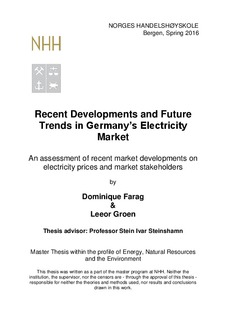| dc.description.abstract | As Europe’s largest economy and as one of the most industrially and technologically advanced
countries in the world, Germany has long been at the forefront of managing and implementing
change in the electricity sector. With the nation’s plans to phase-out nuclear energy by 2022
following the Fukushima Daichii Nuclear Disaster in conjunction with its own ambitious
Energiewende goals of transitioning towards renewable energy, the market has been put under
considerable pressure. Further supported by the rise of Smart Grid, increased decentralized
generation and the interconnection with other European markets, key market participants are
being considerably affected by the scale of change.
To understand the implications of these recent trends, the authors examine the development of
wholesale and retail electricity prices over an eight years period since 2006. They further assess
the impacts on electricity generators and German households as the key market stakeholders
who are affected by the diverging wholesale and retail electricity prices. As a result of the
developments, the authors believe the role of municipalities and cities to be an increasingly
integral part of an effective electricity market in achieving the nation’s goals.
The authors find that as a result of market intervention, the market mechanism upon which
generators have traditionally relied faces considerable pressure. As a direct result, Germany’s
four largest electricity producers are under substantial financial pressure and have had to
drastically redefine their businesses. Moreover, despite the low wholesale price of electricity,
German households are paying amongst the highest prices for electricity in Europe. This is
mainly attributed to the Renewable Energy Surcharge (EEG Umlage), which has increased by
500% since 2006 and in 2015 accounted for more of the household electricity price than the
procurement of electricity itself.
In summary, the authors conclude the paper with an assessment on how the recent market
developments will continue to affect the German electricity supply, demand and prices in the
future. | nb_NO |
